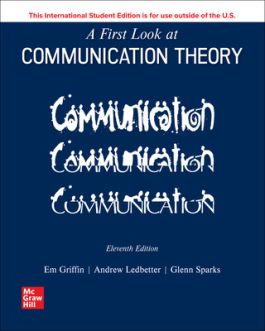A First Look at Communication Theory ISE
Ch. 1: Launching Your Study
Ch. 2: Talk About Theory
Ch. 3: Weighing the Words
Ch. 4: Mapping the Territory
Division Two: Interpersonal Communication
Interpersonal Messages
Ch. 5: Symbolic Interactionism
Ch. 6: Expectancy Violations Theory
Ch. 7: Family Communication Patterns Theory
Relationship Development
Ch. 8: Social Penetration Theory
Ch. 9: Uncertainty Reduction Theory
Ch. 10: Social Information Processing Theory
Relationship Maintenance
Ch. 11: Relational Dialectics Theory
Ch. 12: Communication Privacy Management Theory
Ch. 13: Media Multiplexity Theory
Division Three: Social Influence Persuasion
Ch. 14: Social Judgment Theory
Ch. 15: Elaboration Likelihood Model
Ch. 16: Cognitive Dissonance Theory
Public Rhetoric
Ch. 17: The Rhetoric
Ch. 18: Dramatism
Ch. 19: Narrative Paradigm
Division Four: Group and Organizational Communication
Group Communication
Ch. 20: Functional Perspective on Group Decision-Making
Ch. 21: Symbolic Convergence Theory
Organizational Communication
Ch. 22: Cultural Approach to Organizations
Ch. 23: Communicative Constitution of Organizations
Ch. 24: Critical Theory of Communication in Organizations
Division Five: Cultural Context
Intercultural Communication
Ch. 25: Communication Accommodation Theory
Ch. 26: Face-Negotiation Theory
Ch. 27: Co-Cultural Theory
Ch. 28: Afrocentricity
Gender and Communication
Ch. 29: Feminist Standpoint Theory
Ch. 30: Muted Group Theory
Division Six: Mass Communication
Media and Culture
Ch. 31: Media Ecology
Ch. 32: Context Collapse
Ch. 33: Semiotics
Ch. 34: Cultural Studies
Media Effects
Ch. 35: Uses and Gratifications
Ch. 36: Cultivation Theory
Ch. 37: Agenda-Setting Theory
Division Seven: Integration
Ch. 38: Common Threads in Comm Theories
The discrete presentation of the theories ensures a well-rounded understanding of each while promoting integrative thinking and facilitating the ability of instructors to skip or rearrange their presentation. The broad selection of theories-from the classics to the cutting edge-ensures that students have a solid foundation with which to begin understanding the relationships between theories.
McGraw-Hill Connect is an award-winning digital teaching and learning solution that empowers students to achieve better outcomes and enables instructors to improve course management efficiency.
High-Quality Course Material
Our trusted solutions are designed to help students actively engage in course content and develop critical higher-level thinking skills while offering you the flexibility to tailor your course to the ways you teach and the ways your students learn.
Assignments & Automatic Grading
Connect features a question bank that you can select from to create homework, practice tests and quizzes. Dramatically reduce the amount of time you spend reviewing homework and grading quizzes, freeing up your valuable time to spend on teaching.
Analytics & Reporting
Monitor progress and improve focus with Connect’s visual and actionable dashboards. Reports are available to empower both instructors and students with real-time performance analytics.
Seamless Integration
Link your Learning Management with Connect for single sign-on and gradebook synchronization, with all-in-one ease for you and your students.


